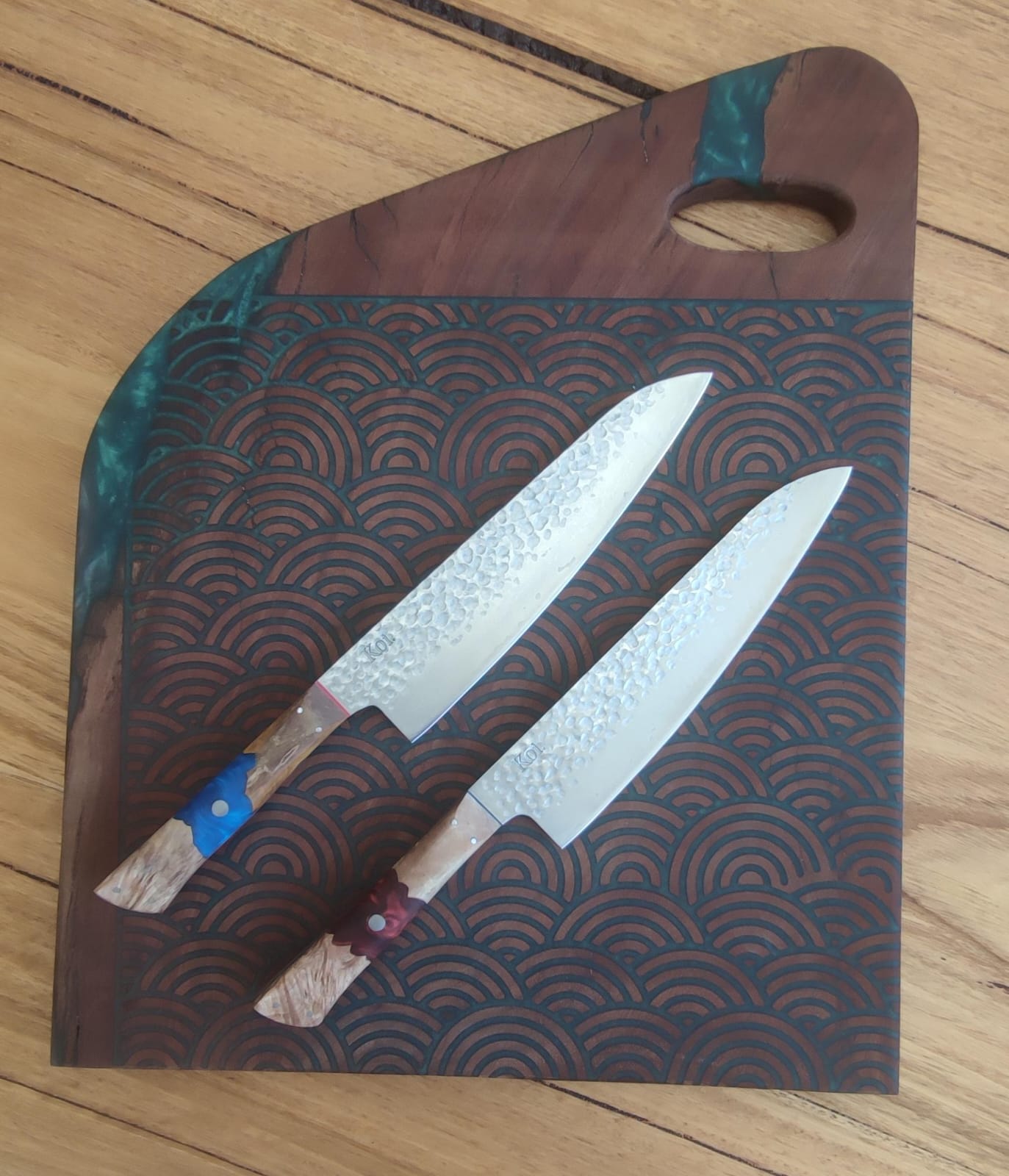Investing in quality knives is just the beginning; maintaining them is the key to a chef's enduring partnership with their tools. This is where the art of whetstone sharpening comes into play, a technique that not only maintains but enhances a blade's potential.
We will delve into the nuanced craft of whetstone sharpening, a method celebrated for its ability to remove minimal metal, preserving the original structure of the blade. This undertaking goes beyond mere upkeep to a commitment to the lasting efficiency of your knives.
Understanding Whetstone Sharpening
Explanation of Metal Removal
When we talk about whetstone sharpening, it's essential to grasp the science behind metal removal. This process is delicate but crucial. Whetstones work by grinding away minuscule amounts of metal from the blade, refining its edge. This precise removal is the key to achieving a razor-sharp edge without compromising the blade's structural integrity.
Preserving Blade Structure for Long-Term Performance
Unlike some aggressive sharpening methods that can alter a blade's composition, whetstone sharpening is a nuanced art. It removes only what's necessary, preserving the original structure of the blade. This meticulous approach is like sculpting, revealing the hidden potential of your knife. By maintaining the knife's structural integrity, whetstone sharpening ensures not just sharpness but long-term durability and peak performance.
Choosing the Right Whetstone
Different Grit Levels and Their Functions
Selecting the appropriate whetstone involves understanding grit levels, akin to the pixels on a screen, defining the sharpness of your knife. Coarser grits, like 200-400, are your initial sculptors, reshaping the edge. Move to medium grits (800-1000) for refining, and then the fine grits (3000-8000) for polishing the edge to razor sharpness. Think of it as a progression, each grit playing a vital role in the knife's journey to peak performance.
Matching Whetstone to Knife Material
Consider your knife's composition. For softer steel, a coarser whetstone is apt, as it removes material efficiently. Harder steel demands a gentler approach, with finer grits to avoid excessive abrasion. This match ensures optimal sharpening without compromising the integrity of the blade. It's a symbiotic choreography, with the whetstone harmonising with the knife, crafting a cutting edge that doesn't just achieve sharpness but also boasts enduring resilience. Choose wisely, and your knife will thank you with sustained, exceptional performance.
Whetstone Sharpening Process
Step-by-Step Guide:
Follow these steps to unlock your knife's true potential:
- Soaking the Whetstone
- Begin by immersing the whetstone in water. Allow it to soak for about 10-15 minutes until air bubbles cease. This ensures the stone is fully saturated, promoting effective sharpening.
- Angle Control Techniques
- Achieving the correct sharpening angle is paramount. For most kitchen knives, a 20-degree angle is a good starting point. Maintain a consistent angle throughout the sharpening process to ensure an even edge.
- Progression through Grits
- Whetstones come in various grit levels, each serving a specific purpose. Start with a coarse grit to repair any damaged edges, then progress to medium and fine grits for refining. Finish with a polishing or honing stone for a razor-sharp edge.
Mastering the Art
Whetstone sharpening is an art form; it's about finesse, not force. Let the stone and the blade dance together. Apply even pressure, and remember, patience is key. As you progress through the grits, observe the evolving sharpness and refine your technique.
Picture this as a journey for your blade – from a rugged trail to a polished highway. Soaking readies it, angle control paves the way, and progression through grits is the transformative scenery.
Embrace the rhythm of this process, and soon, your knife will be a precision instrument, ready to slice through challenges in the kitchen with unparalleled grace and efficiency.
Benefits of Whetstone Sharpening
Longevity of Blade Edge
Whetstone sharpening is your key to a longer-lasting blade edge. Unlike quick fixes that might compromise the metal, the gradual abrasion of the whetstone removes only minimal material, extending the life of your knife. This method ensures consistent sharpness over time, reducing the frequency of sharpening and preserving your blade for the long haul.
Preservation of Original Blade Structure
Maintaining the original structure of your blade is vital for its overall integrity. Whetstone sharpening, with its meticulous process, honors the knife's initial construction. By removing only what's necessary, it safeguards the blade's architecture, preventing unintended alterations and enhancing its resilience against wear and tear.
Enhanced Cutting Performance
A sharp knife is a joy to work with, and whetstone sharpening takes that experience to the next level. The precision achieved through this method translates to enhanced cutting performance. Expect cleaner slices, smoother dices, and an overall improvement in your culinary finesse.
Advanced Tips and Techniques
Honing vs. Sharpening
Understanding the distinction between honing and sharpening is crucial for maintaining a razor-sharp edge. Honing, done regularly with a honing rod, straightens the blade's edge without removing metal. On the other hand, sharpening, executed with a whetstone, is the process of removing metal to redefine the edge.
Recognising When to Sharpen
A keen awareness of when your knife needs sharpening ensures optimal performance. Signs include decreased cutting efficiency, noticeable edge irregularities, and a general sense of resistance while cutting. Regular honing can prolong the need for sharpening.
Maintaining Whetstones for Consistent Results
Consistency is key in whetstone sharpening. Keep your whetstones clean and flat for even sharpening. Clean with a brush and water, and flatten using a leveling stone. Store them properly to prevent contamination. Well-maintained whetstones contribute to a smooth, effective sharpening process, ensuring your blades are consistently honed to perfection.
Summary
In your journey to master the art of knife maintenance, the whetstone emerges as a stalwart ally, and our selection of Naniwa sharpening stones has become the gold standard for precision and performance. Renowned for their exceptional quality, these stones delicately remove minimal metal, not only sharpening but preserving the original blade structure.
Now armed with the knowledge of whetstone sharpening, don't merely sharpen your knives; elevate them with our KOI Whetstone Collection. Embrace the methodical process using stones like the 'Multi-Stone' for versatility, the 'Super Stone S-1' for a razor-sharp edge, or the 'Lobster' for a balanced #3000 grit finish. As a knife enthusiast, you're not just maintaining; you're enhancing with the brilliance of Naniwa.




